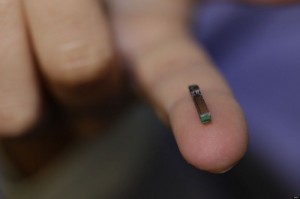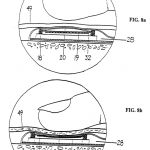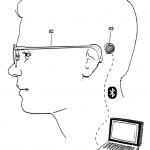Google Implant Chip for Credit Cards, Phone, and Surround Sound
I’ve been pretty tolerant of Google so far. They’ve changed the way people write, forcing them into keyword-centric thinking that forces articles and stories to be front-loaded with phrases and words that could otherwise show up later in a story. They’ve released Google Glass, an obviously controversial move given the current privacy laws. But this week they may have taken the proverbial cake with the introduction of Google Implant.
 The idea of an implanted microchip isn’t new, in fact it’s been around for over a decade. But Google has changed the game in where it will offer the implant and how it will function. Building on the identifying integrated circuits currently placed under the skin of dogs, cats, horses, and other animals, the chip is still about the size of a large grain of rice and uses passive RFID (Radio Frequency Identification) technology. It’s basically a Passive Integrated Transponder (PIT), but also a whole lot more. When these micro-sized RFID tags were created, technology allowed for a small enough footprint to store basic information like address and contact information. The chip is activated by an exterior power source in the form of an RFID scanner which passes electricity passively through the skin to the tag.
The idea of an implanted microchip isn’t new, in fact it’s been around for over a decade. But Google has changed the game in where it will offer the implant and how it will function. Building on the identifying integrated circuits currently placed under the skin of dogs, cats, horses, and other animals, the chip is still about the size of a large grain of rice and uses passive RFID (Radio Frequency Identification) technology. It’s basically a Passive Integrated Transponder (PIT), but also a whole lot more. When these micro-sized RFID tags were created, technology allowed for a small enough footprint to store basic information like address and contact information. The chip is activated by an exterior power source in the form of an RFID scanner which passes electricity passively through the skin to the tag.
Google, however, has figured out how to harness the natural electrical signals generated by the brain. Thanks to advances in cochlear implants, Google is piggy-backing on the technology to power its new Google Implant chip from the neurons surrounding your temporal lobe, which controls, among other things, your hearing. It does this by attaching a small 1/2-inch diameter “net” that acts as a sort of collector/capacitor to grab and store energy from this part of the brain. Chemical and electrical signals connect and pass between the hundreds of millions of neurons in this area. And, since your brain never stops working—even in sleep—the energy source is more or less unlimited for the very small amount of power (.025 mW) needed to power the Google Implant.
The Google Implant Process
Remarkably, Google plans to make the Google Implant available as an “outpatient” service and is already working with facilities around the country to teach and train how this system works. Since the Implant doesn’t actually go “into” the brain, but merely crosses it via tangent, the surgery consists of a local anesthetic, a small incision, and one tiny 1/32″ hole drilled for access to access the surface of the temporal lobe. This may sound frightening, but the brain is actually a pretty resilient organ, according to Dr. Robert Dolus of The Mayo Center:
There is a general sense in which the brain is a very complex device, but when you deal with just the external areas, it’s remarkably adaptable. We see this in cases of concussion and bruising, where the outer dura, arachnoid and pia mater are actually very much self-healing. In our internal trials and clinical evaluations, we’ve found the Google Implant process to be fairly simple and repeatable with no negative side effects and minimal risk to the subject.
Getting a Google Implant is a simple matter of scheduling an appointment and signing the waiver which explains your rights and outlines the general procedure. We got ahold of an advance copy of the waiver and it detailed the three-visit process. On the first visit, you receive your paperwork and a consultation regarding the procedure, as well as instructions on preparing for the out patient surgery. The second visit is the actual surgery, which is done with the patient fully awake and with only local anesthesia for the area right above the left ear. A small incision is made in which the sub-dermal switch is placed, and a small hole is drilled for the insertion of the actual Google Implant and its power “collection net”. The entire procedure is expected to take just 30 minutes. The final visit is a simple checkup and also includes basic tests to ensure the Google Implant is functioning correctly and gathering the required power.
What Can Google Implant Do?
Let’s start with what the Google Implant WON’T do. It won’t allow you to remember everything you see, or store video of every experience you have. There’s simply not enough storage and the interface isn’t that sophisticated. It won’t give you X-ray vision or otherwise augment your faculties in any way. What it WILL do, however is interface with your life in two very specific ways. First, it will serve to store all of your critical information in a two-way connected device. That means you can choose to connect your credit cards, personal information, passwords, etc in the chip—as much or as little as you want. And it connects via Bluetooth for wireless two-way transmission to your smart phone, smart watch or other device. That means that you can store and retrieve just about anything from the Google Implant.
But it does another VERY amazing thing. Since its implanted right above the ear and as part of the temporal lobe, a neat side effect of the Google Implant is that it can access the auditory part of the brain—and in fact it’s optimized to do so. With Google Implant, it can receive Apt-X Bluetooth audio and transmit the signal directly to your brain, bypassing all need for headphones, or even external speakers. Indeed, when properly calibrated, it can provide higher quality audio than any speaker is capable of transmitting, because it bypasses any limitations of the ear and goes directly to the brain. Much of this was made possible through the Mayo Center and their work in the area of cochlear implants. After decades of trial and error, they’ve got the interface pretty much spot on, and it only takes some dialing in with an external computer to complete the tuning and calibrate the system for each user.
What’s even better is that it works on the upcoming Bluetooth 6 profile (though it’s backwards compatible to Bluetooth 1.1) and can therefore allow you to answer calls from your cell phone without requiring you to wear an earpiece or even touch your phone. You can simply touch behind your ear to answer a call, or press and hold to initiate one. Touching it before a call comes in brings up your last-played music track and you can also access voice controls for even more options. The possibilities are endless, and since it uses Bluetooth there are no issues with proprietary standards.
Google Implant also allows for participating in a group broadcast, so up to 16 people can listen to the same source simultaneously. The calibration process even has the capability to configure Google Implant to play back decoded Dolby Digital Plus 7.1 streams. So before you buy that brand new surround system you might want to investigate what’s possible with Google Implant. The system will initially only ship with stereo capability and the ability to run surround tests through software, but Google promises the hardware will follow within 6 months of launch that will integrate with an AV receiver or output device to send up to 7.1 via Bluetooth 6.0 to Google Implant.
And of course, Google is working with retailers to allow the system to transmit secure credit card and bank card info for purchases made in person. Combined with fingerprint or other bio-authentication, this makes for a very secure method of payment for ion-person transactions. Google claims that Implant is completely secure and encrypted with better-than-military-grade security, but we’ll have to see if people will be willing to take this on—and if retailers will participate (NFC payments still have yet to proliferate). Still, even the non-retail capabilities are quite exciting.
When and How Much?
Google Implant will be available starting September of this year, with the surround decode module coming to market by Christmas. It will retail for $999 for the hardware, with agreements in place with local clinics throughout the country to do the surgery for $1500. So for under $2500 you can store and retrieve all of your important information, retrieve files when needed, and enjoy stereo or surround sound without the need for headphones or speakers.
Kinda makes Lasik sound antiquated…






Pingback: RFID Might Become The Next Fashionable Thing |